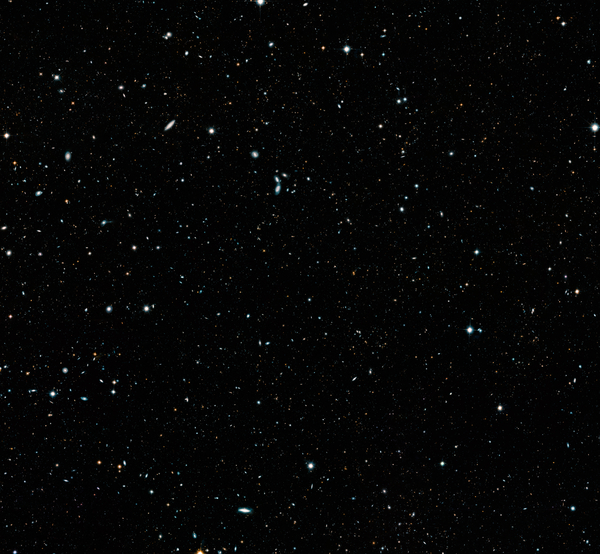Hubble Assembles Wide View of the Distant Universe [heic1909]
2 May 2019
Astronomers developed a mosaic of the distant Universe that documents 16 years of observations from the NASA/ESA Hubble Space Telescope. The image, called the Hubble Legacy Field, contains roughly 265 000 galaxies that stretch back to just 500 million years after the Big Bang.The wavelength range of this image stretches from ultraviolet to near-infrared light, capturing all the features of galaxy assembly over time. The faintest and farthest galaxies in the image are just one ten-billionth the brightness of what the human eye can observe.
"Now that we have gone wider than in previous surveys, we are harvesting many more distant galaxies in the largest such dataset ever produced," said Garth Illingworth of the University of California, Santa Cruz, leader of the team that assembled the image. "No image will surpass this one until future space telescopes like James Webb are launched."
The Hubble Legacy Field combines observations taken by several Hubble deep-field surveys. In 1995, the Hubble Deep Field captured several thousand previously unseen galaxies. The subsequent Hubble Ultra Deep Field from 2004 revealed nearly 10 000 galaxies in a single image. The 2012 Hubble eXtreme Deep Field, or XDF, was assembled by combining ten years of NASA/ESA Hubble Space Telescope observations taken of a patch of sky within the original Hubble Ultra Deep Field.
The new set of Hubble images, created from nearly 7500 individual exposures, is the first in a series of Hubble Legacy Field images. The image comprises the collective work of 31 Hubble programs by different teams of astronomers [1]. Hubble has spent more time on this small area than on any other region of the sky, totaling more than 250 days. The team is working on a second set of images, totaling more than 5200 Hubble exposures.
"One exciting aspect of these new images is the large number of sensitive colour channels now available to view distant galaxies, especially in the ultraviolet part of the spectrum," explained tem member Rychard Bouwens of Leiden University in the Netherlands. "With images at so many frequencies, we can dissect the light from galaxies into the contributions from old and young stars, as well as active galactic nuclei."
Before Hubble was launched in 1990, astronomers were able to see galaxies up to about seven billion light-years away, half way back to the Big Bang. Observations with ground-based telescopes were not able to establish how galaxies formed and evolved in the early Universe. Like watching individual frames of a motion picture, the Hubble deep surveys reveal the emergence of structure in the infant Universe and the subsequent dynamic stages of galaxy evolution. Deep-field views of galaxies such as this help astronomers to trace the expansion of the universe to develop our understanding of the underlying physics of the cosmos. Galaxies also show when the chemical elements originated and enable the conditions that eventually led to the emergence of life.
The image yields a huge catalog of distant galaxies. "Such exquisite high-resolution measurements of the numerous galaxies in this catalog enable a wide swath of extragalactic study," said catalog lead researcher Katherine Whitaker of the University of Connecticut.
The upcoming NASA/ESA James Webb Space Telescope will allow astronomers to push much deeper into the legacy field to reveal how the infant galaxies developed over time.
Notes
[1] The image, along with the individual exposures that make up the new view, is available to the worldwide astronomical community through the Mikulski Archive for Space Telescopes (MAST).
More information
The Hubble Space Telescope is a project of international cooperation between ESA and NASA.
The international team involved in the Hubble Legacy Field consists of G. Illingworth and D. Magee (University of California, Santa Cruz), K. Whitaker (University of Connecticut), R. Bouwens (Leiden University), P. Oesch (University of Geneva), and the Hubble Legacy Field team.
Image credit: NASA, ESA, G. Illingworth and D. Magee (University of California, Santa Cruz), K. Whitaker (University of Conneticut), R. Bouwens (Leiden University), P. Oesch (University of Geneva), and the Hubble Legacy Field Team.
Contacts
Garth Illingworth
University of California, Santa Cruz
Tel: +1 831 459 2843
Email: gillingw![]() ucsc.edu
ucsc.edu
Bethany Downer
ESA/Hubble, Public Information Officer
Garching, Germany
Email: bethany.downer![]() partner.eso.org
partner.eso.org





